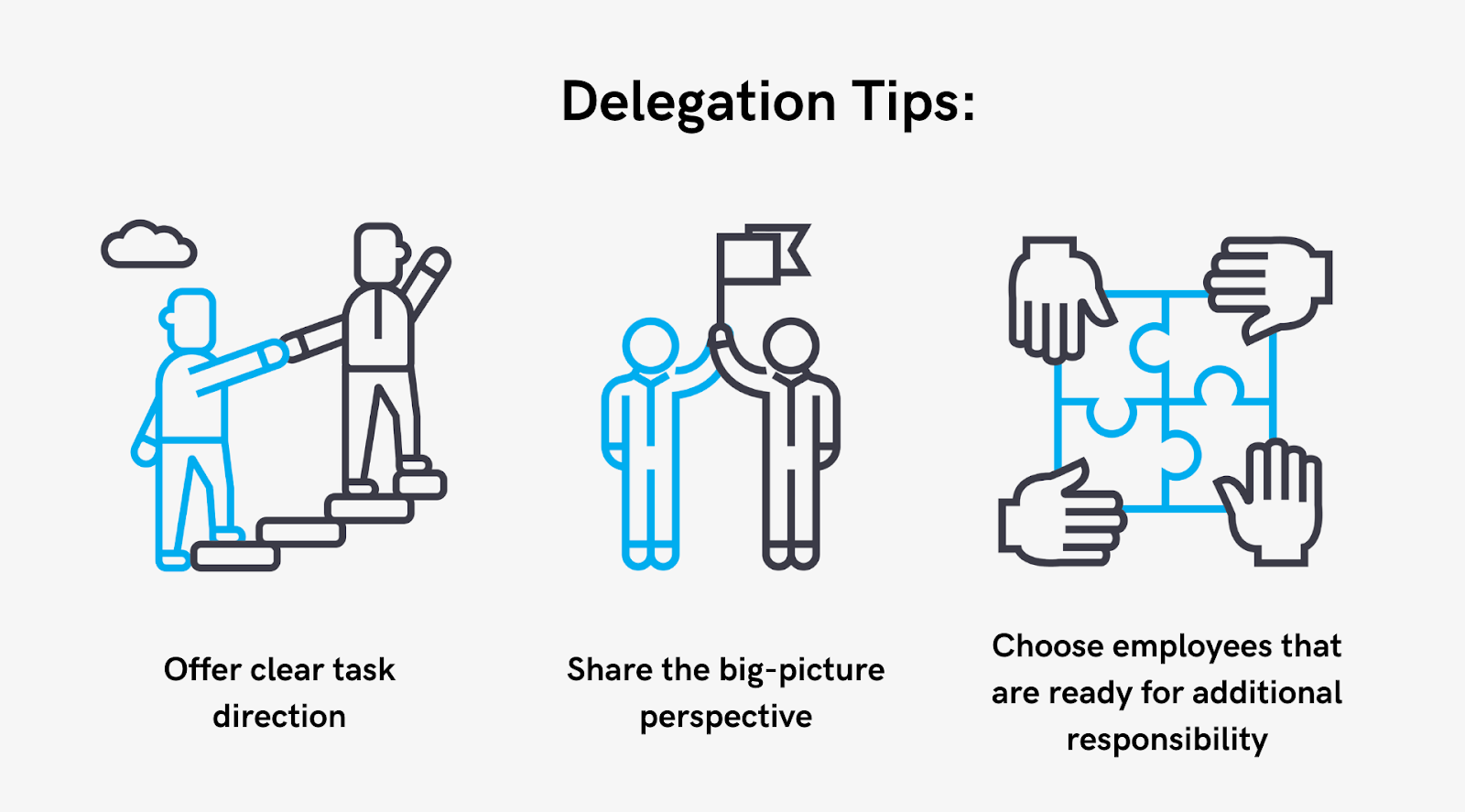When managing a team of employees, no matter the number or size of your organization, there are many different ways to lead. A delegating leadership style is one way to capitalize on your employees’ strengths and spread the workload from one individual to a team of people. A successful delegating leadership style will take time and energy, but it is well worth the effort to help your employees achieve involvement and empowerment in the workplace.

Continue reading this blog to learn the most effective way to utilize a delegating leadership style in the workplace.
Covered in this article:
- What is a delegating leadership style?
- When to use a delegating leadership style?
- What does a delegating leadership style look like for the delegator?
- What does a delegating leadership style look like for those delegated to?
- How to have an effective delegating leadership style
- How to Implement a Delegating Leadership style
- Examples of a delegation leadership style
- Importance of a delegation leadership style
What is a delegating leadership style?
A delegating leadership style allows you to share authority and responsibility with your employees. In this form of leadership, employees are given the ability to complete projects and tasks on their own. Now, this doesn’t mean you give them zero direction. As a manager, you must converse with each employee to assign the task at hand, ensuring they understand and giving them the tools necessary to complete it.
There are many approaches you can take with a delegating leadership style. At Hartman, we lead with a mentorship strategy as we recognize the growth and development of people in the highest calling of leadership. Delegation is an important step in that growth process for both the delegator and delegatee. When focused on delegating properly, you can establish yourself as an effective leader.
Delegation, at its core, is an integral step to becoming an effective leader and a vital practice for those you lead to develop themselves individually.
When to use a delegating leadership style?
There are countless benefits to a delegating leadership style. You might utilize this leadership style if you require a specific employee’s skill set for a project, if you need help hitting a project deadline, or if you need assistance managing a particular task. In a delegating leadership style, you provide employees with insight into the big picture and allow them autonomy in executing individual tasks.
A delegative leadership style looks different from the perspective of the delegator versus the individual. Depending on each perspective, you can expect different behaviors, both of which we’ll review below.
What does a delegating leadership style look like for the delegator?
When delegating, the delegator expects to share the workload and direct and review until the task is final. Here are some action examples a delegator can take:
- The delegator provides the delegate with the “big picture” while relinquishing control of individual tasks to achieve the goal.
- The delegator turns over control of specific tasks to the employee.
- The delegator advises and monitors tasks but allows autonomy in execution.
- The delegator remains accessible for guidance, answers questions as they arise, and provides feedback on results.
What does a delegating leadership style look like for those delegated to?
Here are some action examples a delegatee can take:
- The delegate operates autonomously on the assigned tasks.
- The delegate performs at a high level similar to that of the delegator.
- The delegate remains committed to the task until completion.
- The delegate regularly updates the leaders on task updates, progress, and any issues related to task completion.
- The delegate possesses high self-awareness in their ability and skill related to completing the task.
How to have an effective delegating leadership style
Thoughtful and purposeful leadership is a vital component of excellence in the workplace.
It takes the right type of leadership to achieve effective delegation.

Here are a few tips to support effective delegation:
Tip #1: Choose employees that are ready for the responsibilities you’re delegating to them.
Tip #2: Share the big-picture perspective.
Tip #3: Offer clear task direction from the beginning.
Tip #4: Establish clear deadlines.
Tip #5: Plan for check-ins along the way.
Tip #6: Remain flexible: sometimes effective delegating means explaining the task and trusting the individual to execute the task in their own way, even if it is different from how you would have achieved the task.
Tip #7: Remain aware of the project, and step in if something goes wrong. You are still ultimately in charge of the end product.
How to Implement a Delegating Leadership style
Many leaders are curious about the benefits of a delegative leadership style but are unclear about how to start. Specific steps are crucial in implementing a delegating leadership style for the first time within your organization. Here are a few additional tips:
Tip #8: Ensure you intimately understand the skills and capabilities of the employees you’re delegating to. Some employees may require more direction or check-ins, while others may need more encouragement and positive affirmations. Understanding employee abilities and needs are critical to successful delegation.
Tip #9: Continuously communicate throughout the process. This includes clearly defining the task, deliverables, and expectations and then continuing the communication with check-ins and feedback.
Tip #10: Effective delegation requires positive feedback when the task is complete. Make a point to celebrate employees when they can successfully complete a delegated task to the established specifications and timeline.
Top leaders can channel their egos and agendas into a purpose bigger than themselves. When delegation is used effectively, leaders can utilize the individual skills of their team members to most efficiently achieve the end goal. Great leaders build teams with groups of individuals who are all interested in doing their part to achieve a greater objective.
Examples of a delegation leadership style
Let’s look at two examples of how a delegating leadership style can be executed effectively and ineffectively.
Example A: A technology company used a hands-off management style to help attract highly skilled engineers. Once recruited, engineers were allowed the flexibility to creatively execute company-established design projects around creating personal tablets. Through the flexibility of delegation, these engineers were responsible for creating products that catapulted the company into becoming a household name.
Example B: Engineers at a similar technology company are hired with the promise of design flexibility and autonomy. Their manager gives them very unclear guidelines and no timeline for task completion. After three months, the manager is unhappy that the engineers have not created a viable product to take to market. The engineers feel they were unfairly treated without being given clear and reasonable guidelines.
It is clear that in example B when the delegated task was not defined properly or managed correctly, there was a lack of success in the end product. To be successful, a delegating manager should have determined a desired timeline for product completion at the onset of hiring and checked in on project progress along the way to ensure it was moving in the right direction.
Importance of a delegation leadership style
A truly effective leader implementing a delegation leadership style knows how much free rein the delegate can adequately manage and adjusts their communication and supervision processes to meet the needs and skill level of the delegate.
Becoming a better leader is a continuous process of learning and adjustments. Successful delegation takes consistent time and energy but is well worth the effort when it supports your employees’ development, company and team involvement, and individual empowerment.






